Is celebrating Christmas with a tree and gifts wrong?

Is celebrating Christmas with a tree and gift exchanging considered wrong? Because it says somewhere in the Bible we are not to celebrate pagan holidays/sungod feast. So, are we celebrating, in a sense, a pagan holiday?
— Royce Wheat, by e-mail
A Christmas is a Christian holiday that celebrates the birth of Jesus the Christ. The word “Christmas” has its origin in late Old English Cristes Maesse, the Mass of Christ. Western Christians observe the holiday on December 25 of each year, according to the Gregorian calendar, whereas Eastern Orthodox Christians, who still follow the Julian calendar for determining feast days, celebrate the holiday 12 days later.
The first observance of the feast took place in Egypt around A.D. 200, when Clement of Alexandria (3rd century philosopher, scholar and theologian) set the date as May 20. By the 4th century, when Christianity became the official religion of the Roman Empire, the observance of Christmas on December 25 became common practice, supposedly in opposition to the festival surrounding the winter solstice (Natalis Invicti) and the pagan feast celebrating the birth of the sun god (Sol Invictus). Analogies were drawn between Christ and the sun — the rising sun as a symbol of Christ's resurrection, and Christ as the “Sun of righteousness” (Malachi 4.2, King James Version). Composer Charles Wesley's (1707-1788) words from the third stanza of the beloved Christmas carol, “Hark! The Herald Angels Sing,” are based on the Malachi passage:
Hail the heav'n born Prince of Peace!
Hail the sun of righteousness!
Light and life to all he brings,
Ris'n with healing in his wings.
Another reason for the selection of December 25 as the day to celebrate Jesus's birth is that it follows nine months after the Festival of the Annunciation (March 25), the date for commemorating the angel Gabriel's announcement to Mary that she was chosen by God to be the mother of God's Son.
Legend has it that the 16th-century reformer Martin Luther began the tradition of decorating trees to celebrate Christmas after walking through the woods on Christmas Eve and being struck by the beauty of evergreen trees dusted with snow and shimmering in the moonlight. He then set up a tree in his home and decorated it with candles that were lit in honor of Christ's birth and the true light that came into the world (John 1.9).
Many churches today decorate trees placed in their sanctuaries with “Chrismons” — ornaments in the shape of Christian symbols that are white with gold beads, ribbon or glitter. The term comes from the Latin Christi Monogramma — the literal monogram of Christ, Chi Rho, which is the Greek letter X (chi) superimposed upon the letter P (rho). The tradition of gift giving at Christmas can find its source with the gifts brought to the Christ Child by the Magi as a way of honoring him (Matthew 2.11).
[This question was answered by Barbara Bernstengel, retired director, Education Unit, Nida Institute for Biblical Scholarship.]
Thank you to those who responded to our Facebook posting with suggested questions for this column. We will be reviewing them for inclusion here.
Thanks to the support of our faithful financial partners, American Bible Society has been engaging people with the life-changing message of God’s Word for more than 200 years.
Help us share God's Word where needed most.
Sign up to stay in touch with how God is changing lives with his Word!








